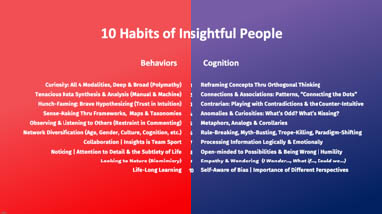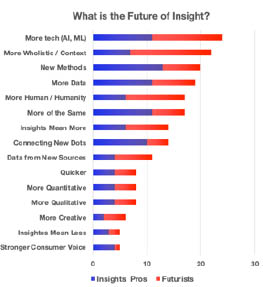In 2030, The Nobel Committee Awards Its Inaugural Prize for Insight Science
Editor’s note: I am delighted by the creative approach author, insight scientist, and futurist Sarah DaVanzo takes in this speculative futures piece. Sarah incorporates data from a global research study conducted early in 2020 of 155 insights professionals and 24 futurists, combined with industry trends, to offer a provocative sci-futures vision of a possible, plausible, and preferable future of the insights field. This piece not only illustrates the convergence of the insight and foresight fields, but it also applies foresight to the insights profession. Like the cobbler’s children without shoes, sometimes we don’t pause to apply insight and foresight methods ourselves and in our profession. We hope this thought experiment stimulates discourse.
— Schools of Thought Feature Editor Karen Lynch
(December 10, 2030, Nobel Award Ceremony, Stockholm Concert Hall, Sweden)—Good evening, and welcome to the Nobel Awards of 2030. My name is Sarah DaVanzo, and I’ll be your Master of Ceremonies for the evening.
It’s the 135th anniversary of Alfred Nobel’s death. The extraordinary inventor, chemist, engineer, and businessman was such a master of insight, it’s only fitting that tonight I have the honor of announcing the first Nobel Prize for Insight Science. This discipline combines the art of insight with the rigor of science. Like dynamite, one of Nobel’s 355 inventions, catalytic ideas require an ignition spark. This, ladies and gentlemen, is a flamethrower.
Today’s first Nobel Prize in the field of Insight Science is awarded to a diverse team at the Insighting Institute of INSEAD. The team, made up of both natural humans and cyborgs, demonstrates the best synthesis of human and machine learning. Before we invite the team to the hologram stage to accept the Nobel Prize for Insight Science, I’d like to share a brief history of how this new Nobel award came to be.
Insight Recession
A decade ago, in the early 2020s, a number of forces posed existential threats. You will recall that the world was in upheaval. The COVID-19 pandemic raged. Economies collapsed. Unemployment soared, and there were a number of climatic and ecological catastrophes. On all continents, violence, terrorism, and cultural clashes erupted with greater frequency.
Many of you will recollect that Big Tech (i.e., Amazon, Facebook, Google) seized the moment by consolidating, repositioning, and morphing into insights engines harnessing data from all aspects of people’s lives. Demographics and sociographics were derived from media, browsing, spending, searches, ratings, and reviews. Emotional data came from people’s relationships with Alexa and Siri. Biological data was harvested from companies like 23andMe, and data also poured in from devices—cellphones, VR headsets, cars, smart watches, smart TVs, smart homes, and smart city infrastructure. Most people had not yet developed the skills to manage their data. This coincided with research showing a general decline in human curiosity, focus, empathy, engagement, productivity, and insightfulness.
For those of you who remember what life was like in 2020, you’ll recall businesses, institutes, and governments were frantically hunting for faster, cheaper, and deeper insights—spawning insights factories. Market researchers were losing their jobs to AI-automated insights platforms. In 2025, Wall Street launched the Open Insight Exchange, trading and speculating on insights. Remember back in 2026, when a rare 100 percent natural human-generated insight (i.e., a natsight) was auctioned for $1.4 billion. Those were crazy, stressful, and disruptive times.
Insight Intervention
Today, in 2030, as you all know we enjoy a thriving global economy, peace, freedom, and wealth. COVID-19 and the climate are under control, and humanity is thriving—bursting with diversity, literacy, and curiosity. Health and well-being have improved, and happiness is flourishing. We leaped from a path of scarce insights (2020) to one of abundant insights (2030). With insight abundance came deeper understanding and collaboration, which enabled us to generate solutions to our wicked problems and improve the human condition. Historians attribute the course correction to three interrelated strategies: Reframed Insight, Augmented Insight, and importantly, Insight Science.
Reframed Insight
In the face of AI and Big Tech, humans leaned into their humanity. Humans realized that their competitive advantage over AI is the ability to think orthogonally. “Reframing” became a coveted competency in the early 2020s. It was the focus of much academic attention. You may recall the countless articles on how to “reframe” topics to unlock new solutions. The seminal cover article of Harvard Business Review (May 2022), titled “Reframe Everything,” encouraged leaders to challenge paradigms and creatively reimagine all topics. Inspired by this, market researchers reframed insight.
Assumptions about insight were challenged, one of the biggest being the notion that insight is something one discovers. Instead, researchers started to view insight as something “conjured” or summoned; insight could be attracted given the right conditions, like using bait to catch an elusive animal. The externalization of insight broke new ground. Some posited that insight was a force of nature with mass, gravity, and velocity. Other “reframers” applied quantum mechanics to insights in pursuit of “quantum insight.”
There were three particularly provocative theories about insight from the reframing movement of the 2020s:
- Insight is simply neurochemistry: The neurochemicals in the brain that accompany an insightful “eureka moment” were reverse-engineered in 2024, as most of you know; designer cocktails of neurochemicals were found to induce different kinds of insights. It became fashionable for researchers to use deep-brain electroshocks and psychedelic micro-dosing to reboot the brain and generate insights. Who didn’t have an Rx for “neurcotics” in 2026?
- Transplanted insights: After gut microbes were linked to personality, depression, IQ, and behavior, the biome of insightful people was mapped in 2024. Remember when everyone started drinking probiotic insight-performance drinks in 2025? Biome transplants from insightful people’s Biome Bank became trendy (I was gifted with Dalai Lama biome in 2027). This was quickly followed by the discovery of the contagiousness of insight leading to the birth of insight social networks, like Insigram, dedicated to spreading insightfulness.
- Lab-grown insights: Scientific advances in biotech, such as 3-D printing brain matter, resulted in the lab-grown mini-brain industry. I have a few mini-brains in my purse right now in case I need some extra insight tonight. Do you remember when Intelligence Quotient diagnostics were replaced by Insight Quotient tests in 2026? That was a time when vertical farms in dense urban areas started to specialize in cortex farming.
 What are the behaviors and cognition exhibited most frequently by insightful people?
What are the behaviors and cognition exhibited most frequently by insightful people?
Augmented Insight
Around 2023, humans realized that they needed to leapfrog Big Tech and AI to regain control of the insight process. The scientific community acknowledged the limitations of human biology constraining and capping insights; humans had maximized their natural biological insight potential so the only way to elevate insights was to augment.
A trend began in 2025 in which humans started augmenting their brains with technology to boost insight abilities to become faster, smarter, and more efficient at mining insights. This was the moment the Augmented Human, or “Aug,” population exploded. Augs were added to the censuses of several nations in 2026, resulting in the establishment of the Aug Disclosure Act in the United States to level the playing field.
Technology became both the best thing for—and the worst threat against—cultivating insight. Emerging tech from Silicon Valley in the early part of the last decade focused on synergizing technology and biology to unlock insights. Three branches of Aug tech evolved:
- Internet of Self (IoS): Smart environments, smart textiles, and the Internet of Things evolved into bio-hacking, including transfusions of smart blood, embedded microchips, and smart exoskeletons collecting increasingly intimate consumer data. Wearables became “speakables” and then “thinkables.” Advances in brain/computer interfaces, neural dust, and neural lace enhanced human information processing; memories and experiences were first implanted in 2026, spawning the implanted insight
- Digital Sensing: Technologies enhanced or replaced human senses creating novel synaesthetic experiences (e.g., tasting color), resulting in completely new ways of processing information to unlock insights. Sensory amplification and deprivation clubs became fashionable in 2025 to engineer perception, data synthesis, and ultimately insight generation.
- Digital Twins: Avatars gained mass popularity around 2026, which enabled data analysis through the unbiased (or intentionally biased) lens of virtual humans to unlock insights. Virtual Reality communities, bots, and AI assistants became industry standard by 2024 for data analysis, leading to new insight discovery methods and digital insight outputs.
Data that had been invisible and hidden since the beginning of time were made visible with new technologies. Suddenly humans could see Wi-Fi signals, see through walls, read breathprints and emotions, decode thoughts and intentions, and more. New data sets brought new insights. Swarms of drone cameras, microscopic nano-cameras, and invisibility science gave humans new perspectives. New perspectives resulted in new insights.
Insight Science
In 2020, a controversial research study found that the insights profession was more art than science, whereas most professions were adopting STEM and systems-thinking practices. The study found that the insights profession lacked common language and proven best-practice methods. It was shocking when it was exposed that everyone was inefficiently working off of a different playbook in the insights field; and the field was siloed and competitive. Recall the scandal that ensued from the revelation that there were no return-on-insight metrics and that the insights field was woefully lacking in diversity.
In response, and to reframe the insight profession, market researchers around the globe rallied to form a new branch of science called Insight Science. They established seven principles of this scientific discipline with the mnemonic device S.C.I.E.N.C.E.:
- Systems Thinking—Collectively sharing and optimizing methods to design an insights ecosystem and community, in response to the siloed and solitary nature of the insights profession and lack of universal industry protocols.
- Curiosity—Measuring and cultivating broad curiosity (polymathy) and deep curiosity, leveraging all four curiosity modalities: intellectual, observational, sensorial, and experimental curiosity.
- Impact—Measuring return-on-insights (ROI) by tracking the transformation of insights into business impact, given the lack of metrics and best practice examples of insights-into-action.
- Experiments—Conducting research, experiments, and gathering data to identify best practices and improve, as a counterpoint to the theoretical and subjective nature of insights methods.
- Novelty through Diversity—Ensuring diverse perspectives in both the work and the people doing the work (talent pool), to offset the lack of diversity in the field.
- Codified Knowledge—Capturing, classifying, and sharing key concepts, learning, and lexicon, as an antidote to wild disagreement on insights terminology (no universal definition for consumer insight, consumer tensions, need states, etc.).
- Equipment—Building technologies, tools, and platforms to amplify the craft, and investing in technology training given the tech-shyness of the insights industry.
Abundant Insight 2030
As you are well aware, and the reason we are gathered today, the science of insights is thriving. Courses and degrees in Insight Science can be found at leading universities around the globe. There is a globally-recognized professional certification for insight scientists, as well as a flourishing network of insight scientist apprenticeships. There are Insight Science laboratories on every continent and grant money flows into Insight Science research and development. Several accelerators focused on Insight Science are located in the technopole of Austin, Texas. The U.S. government established a cabinet position, Secretary of Insight Science, parallel to Britain’s Ministry of Insight Science. Finally, as stated earlier, the Institute for Insight Science opened its doors in 2028.
Today, insights flow abundantly. The future is bright with insight. While the early 2000s are referred to as the “Information Age,” and the 2020s the “Knowledge Age,” 2030 marks the dawn of the “Insight Age.” With that said, Nobel Prizes are awarded “to those who, during the preceding year, have conferred the greatest benefit to humankind. In the presence of the King of Norway, on behalf of the Nobel Committee, I am honored to invite to the stage to accept the first Nobel Prize of Insight Science…
Source:
• Insights About Insight study (2020), www.insightscience.com
Defining Insight
Insight = inside (in) seeing (sight). Inner sight. Inside sight. Seeing what is hidden and not obvious (not easily perceived and understood). Insight is understanding the inner workings of a phenomenon; the inner or underlying dynamics of people, places, things, and ideas.Defining Foresight
Foresight = seeing forward. Forward sight. Future seeing. Knowledge or insight gained by looking forward.Habits of Highly Insightful People
The research uncovered alignment on the characteristics of insightful people. The top quality of insightful people is “curiosity,” with 70 percent of respondents citing that “curious people are more insightful.” Sixty-four percent responded that insightfulness is a learned, teachable skill (“a muscle-needing exercise”), with 51 percent saying they would like coaching to improve their insightfulness.About the Research
The research study titled “Insights About Insight,” informed the creation of a new field called Insight Science. The study fielded April–June 2020 surveyed 155 insights professionals from Brazil, China, France, Germany, India, Japan, Korea, Nigeria, Singapore, Spain, South Africa, the U.K., and the U.S.Respondents spent an average of thirty-two minutes responding to a twenty-six-question digital survey (mostly open-ends), generating responses totaling 59,000 words. Respondents spanned an array of insights roles: internal/client insights (CMI, CMK), agency strategic planners, market researchers, and freelance consumer insights strategists. Verbatims were analyzed, and responses were coded and quantified. An emotion-recognition AI platform (QNTFY.com) analyzed the underlying emotions of responses. Twenty-four leading futurists contributed their perspectives on the future of insights. The research report can be downloaded at www.insightscience.com.
In 2020, a controversial research study found that the insights profession was more art than science, whereas most professions were adopting STEM and systems-thinking practices. The study found that the insights profession lacked common language and proven best-practice methods. It was shocking when it was exposed that everyone was inefficiently working off of a different playbook in the insights field; and the field was siloed and competitive.
The Future of Insight
Top predictions for the future of insight: There is alignment that the future of insights will be more tech-driven (from AI and machine learning); however, 68 percent mentioned something like “the expectation of real-time insights is ruining insight.” Insights pros envision a future of more data, from new data sources, which will require new methods. Futurists envision more 360-degree, wholistic, and contextual insights.

Insights professionals and futurists predict that the future of insights will be more tech-driven.





2 Trackbacks / Pingbacks